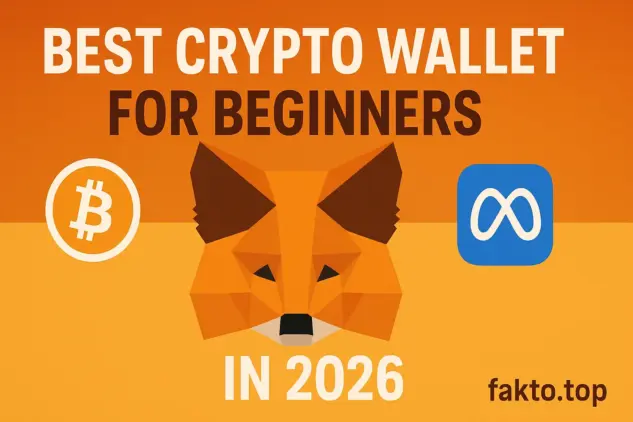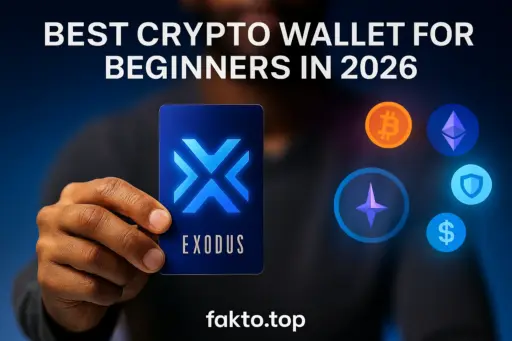Best Crypto Wallet for Beginners in 2026
MetaMask or Exodus? Find the Best Crypto Wallet for Beginners in 2026
Stepping into crypto can feel like entering a labyrinth with flashing lights, confusing signs, and a few dragons hiding behind spreadsheets. Before buying your first Ethereum or Bitcoin, you’ll need a safe spot for your digital treasures. That’s where the hunt for the right crypto wallet begins.. Okay, just kidding — but seriously, two wallets dominate the beginner scene in 2026: MetaMask and Exodus. Both are user-friendly, loaded with features, and perfect for dipping your toes into the crypto pool without drowning in complexity.

MetaMask wallet review 2026
Why is MetaMask so popular with beginners? Simple. It turns blockchain from a cryptic puzzle into a “click-and-go” experience. With a browser extension or the MetaMask mobile app review 2026, you can create a wallet in minutes, manage multiple tokens, and even start exploring DeFi projects without losing your mind. Beginners love the clean interface and cross-platform convenience, which makes checking balances or swapping tokens feel almost fun.
MetaMask supports Ethereum and any ERC-20 token, along with other networks like Binance Smart Chain, Polygon, and Avalanche. You can add custom networks easily, meaning your favorite tokens and dApps will probably work without a hitch. Imagine juggling multiple collectible cards, but digitally — that’s how token management feels here.
Cross-platform usage is another plus. The mobile app isn’t just a companion; it’s a fully functional wallet. You can send crypto while waiting for coffee, check your DeFi investments on the bus, or approve a smart contract without booting your laptop. Convenience like this keeps beginners engaged and reduces the fear of “losing access” to funds.
MetaMask features 2026
- Multi-network support (Ethereum, BSC, Polygon, Avalanche)
- Custom token tracking
- Built-in swaps for ERC-20 tokens
- DeFi integration (lending, staking, yield farming)
- NFT management and marketplace connection
- Hardware wallet integration for added security
Gas fees often confuse beginners, but the MetaMask gas fees explanation 2026 has become more transparent. You can pick “slow,” “average,” or “fast,” seeing real-time prices in gwei. It’s like choosing express shipping for your crypto — patience costs less.
How to set up MetaMask wallet
- Download the browser extension or mobile app.
- Click “Create Wallet” and set a strong password.
- Save your seed phrase securely — think of it as a master key. Losing it means losing access forever.
- Confirm your first transaction by sending a small amount to yourself to test.
Seed phrase safety can’t be stressed enough. Beginners sometimes store it in notes or screenshots — don’t. Treat it like a treasure map, hidden offline and never shared.

How to use MetaMask with dApps
Connecting to DeFi platforms is as simple as pressing “Connect Wallet.” NFT marketplaces? Same deal. But remember, always double-check URLs to avoid phishing scams. Using MetaMask integration with dApps safely is crucial — think before you click. This wallet shines for beginners who want to experiment with DeFi and NFTs without getting lost.
In short, MetaMask combines convenience, multi-network support, and DeFi friendliness. Pros include ease of use, broad token compatibility, and dApp integration. Cons? Gas fees can be high, and security relies heavily on proper seed phrase management.
| Pros | Cons |
|---|---|
| Beginner-friendly interface | Gas fees can be confusing |
| Supports multiple networks and ERC-20 tokens | Security depends on user handling seed phrase |
| DeFi and NFT integration | Mobile app can feel cluttered for some |
Next up, we’ll explore Exodus wallet review 2026, which approaches beginner crypto differently — more like a polished Swiss Army knife than a single-purpose tool.
Exodus wallet review 2026
Unlike MetaMask, Exodus takes a “full-service” approach. If MetaMask is like a sporty hatchback for crypto, Exodus is the SUV with leather seats and a built-in GPS. It’s beginner-friendly, visually appealing, and surprisingly powerful under the hood. In 2026, Exodus wallet for beginners still ranks high because it balances ease of use with multi-currency support and built-in exchange features.

Exodus wallet for Bitcoin and Ethereum is simple to set up. You download the app or desktop version, create a wallet, and immediately see your portfolio in a clean dashboard. Unlike some wallets that feel like spreadsheets, Exodus presents your assets with charts, balances, and transaction history — almost like a friendly financial advisor.
It’s considered one of the best multi-currency wallets 2026 because it supports over 200 cryptocurrencies. You can hold BTC, ETH, ERC-20 tokens, and dozens more, all in one place. Beginners don’t have to juggle multiple apps or accounts; Exodus keeps everything under one roof. If you’re someone who likes to experiment with different coins without turning your life into a tangle of addresses, this wallet is a dream.
Exodus wallet security features
Security matters, and Exodus doesn’t disappoint. Local key storage ensures your private keys never leave your device. Backup options allow you to restore access if your computer crashes — just keep your 12-word recovery phrase offline. For beginners, it’s comforting to know the wallet doesn’t rely on cloud storage or third-party servers. Still, responsibility lies with you; treat the recovery phrase like a treasure map.
Exodus wallet exchange: how beginners can benefit
One standout feature is the wallet with built-in exchange. You can instantly swap one cryptocurrency for another without leaving the wallet. Fees and limits are transparent, and the process is intuitive. If you want to trade ETH for BTC or try an ERC-20 token, it’s like having a mini exchange inside your wallet — safe, simple, and fast.
Exodus wallet tutorial for beginners is straightforward: install, secure your recovery phrase, and optionally connect to a hardware wallet for extra security. First transactions are simple; send a small amount to test, then gradually expand your portfolio. Private key management is transparent — you always know where your keys are and how to back them up.
Pros include an intuitive interface, multi-currency support, and a built-in exchange. Cons? It’s less optimized for DeFi, and advanced dApp integration is limited compared to MetaMask. The wallet is ideal for those who value portfolio visibility, design, and simple swapping over heavy DeFi interaction.
| Pros | Cons |
|---|---|
| Beginner-friendly interface | Limited DeFi dApp integration |
| Supports 200+ cryptocurrencies | Fees slightly higher than dedicated exchanges |
| Built-in exchange inside the wallet | Mobile app not as feature-rich as desktop |
Next, we’ll compare MetaMask vs Exodus directly, covering interface, supported blockchains, NFT and DeFi support, and which is best for beginners in different scenarios. Spoiler: the choice often comes down to whether you want a DeFi-first wallet or a multi-currency portfolio hub.
MetaMask vs Exodus — which one is better for beginners?
Alright, let’s get down to the showdown everyone’s been waiting for: MetaMask vs Exodus. Think of it as a friendly debate between two wallet styles. MetaMask is your go-to for DeFi and Ethereum dApps, while Exodus feels like the all-in-one portfolio manager. Which one should a beginner pick? It depends on your goals.

Interface comparison
MetaMask has a minimalistic, browser-first interface. You can access it via the MetaMask mobile app review 2026 too, but it shines on desktop when connecting to dApps. Exodus, on the other hand, is visually rich and intuitive, showing charts, balances, and portfolio performance at a glance. Beginners often prefer Exodus for tracking multiple coins because it feels like a personal dashboard rather than a toolkit.
Supported blockchains
MetaMask primarily focuses on Ethereum and ERC-20 tokens but allows network expansion to BSC, Polygon, and Avalanche. Exodus supports over 200 cryptocurrencies across multiple blockchains. If your plan is to diversify holdings beyond Ethereum, Exodus wins. But for DeFi adventures, MetaMask is the heavyweight champion.
NFT and DeFi support
MetaMask for NFTs 2026 is robust — you can store, trade, and interact with marketplaces easily. DeFi wallet options, including staking and lending, are well-integrated. Exodus offers NFT support via wallet display but lacks deep DeFi integration. So, if your goal is exploring Ethereum dApps, MetaMask integration with dApps makes life simpler.
Exodus for multi-currency storage vs MetaMask for dApps
Think of Exodus as a vault for your diverse crypto collection. MetaMask is more like a smart key for unlocking DeFi doors. Beginners who want variety and a clear overview of holdings often lean toward Exodus. Those ready to play with DeFi platforms, yield farming, or NFTs lean MetaMask.
MetaMask vs hardware wallet
For extra security, MetaMask can integrate with a hardware wallet. That way, private keys stay offline while you still enjoy the convenience of MetaMask’s interface. This combination is ideal if you want DeFi access without compromising security.
| Feature | MetaMask | Exodus |
|---|---|---|
| Ease of use | Beginner-friendly, DeFi-focused | Highly intuitive, portfolio-focused |
| Supported blockchains | Ethereum + layer-2s | 200+ coins across multiple chains |
| DeFi integration | Excellent | Limited |
| NFT support | Strong | Basic display only |
| Built-in exchange | Swaps only | Full wallet with built-in exchange |
| Security | Depends on seed phrase; hardware integration optional | Local key storage, recovery phrase |
Q&A for beginners
- Which wallet is better for trading Ethereum? MetaMask is ideal for direct interaction with DeFi platforms, while Exodus provides simple swapping.
- Which is safer? Both are secure if you manage seed phrases responsibly; hardware wallet integration enhances MetaMask security.
- Can I store multiple coins? Exodus easily supports dozens of coins; MetaMask focuses on Ethereum and tokens.

Bottom line: if you’re here to explore DeFi, interact with dApps, or collect NFTs, MetaMask wallet review 2026 wins. If you prefer a polished, multi-asset portfolio and straightforward swaps, Exodus wallet review 2026 takes the crown. Either way, both wallets are excellent choices for beginners ready to step into crypto in 2026.
Next, we’ll look at the best wallet for Ethereum and DeFi in 2026, covering token storage, trading, and practical tips for beginners.
Best wallet for Ethereum and DeFi in 2026
So, you’ve explored MetaMask and Exodus, and now you’re wondering: what’s the best Ethereum wallet 2026? If your main focus is Ethereum, ERC-20 tokens, and DeFi adventures, it’s important to choose a wallet that’s not just secure, but also functional for daily use. MetaMask and Exodus each have their strengths here, depending on whether you prioritize dApp interaction or portfolio management.
MetaMask shines as a crypto wallet for Ethereum 2026. It allows you to store ERC-20 tokens, interact with Ethereum dApps, and participate in DeFi projects like staking, lending, and yield farming. The best wallets for Ethereum dApps typically need fast, seamless connections to decentralized applications, and MetaMask does this brilliantly. Beginners can start small, sending a tiny amount of ETH to test transactions before diving into bigger moves. Gas fees are shown in real-time, so you won’t be caught off guard.
Exodus is less about dApp interaction and more about managing multiple assets. For beginners who want to trade Ethereum or hold ERC-20 tokens alongside Bitcoin and other altcoins, Exodus is a solid choice. Its wallet with built-in exchange allows instant swaps without leaving the interface, making it simple to trade Ethereum against other cryptocurrencies safely. The best wallet for trading Ethereum often depends on whether you want hands-on DeFi engagement (MetaMask) or streamlined portfolio control (Exodus).
When storing ERC-20 tokens, both wallets require attention to security. MetaMask relies on secure seed phrase storage and optional hardware wallet integration for MetaMask, giving an extra layer of protection. Exodus wallet private keys management is transparent: your keys never leave your device, and you can back them up using a 12-word recovery phrase. This makes both options viable as a secure crypto wallet for 2026 — the key is responsible handling.
Best wallet for DeFi in 2026
MetaMask remains the go-to for DeFi activities. Whether you want to lend, stake, or provide liquidity, it integrates with most platforms. Beginners sometimes worry about losing funds, but careful seed phrase storage and avoiding phishing links dramatically reduce risks. Exodus, while not a DeFi powerhouse, still allows basic swaps and holdings, making it more of a portfolio hub than a trading desk.
Security tips for beginners cannot be overstated. Always store your seed phrase offline, beware of phishing sites, and understand the risks of mobile vs desktop wallets. Losing funds usually happens due to careless handling rather than the wallet itself. Following a basic checklist — secure seed phrase, verified download, and cautious transaction testing — is enough to keep most users safe.
In 2026, the choice between MetaMask and Exodus depends on what you want to do with Ethereum. MetaMask is perfect for DeFi enthusiasts and NFT collectors. Exodus excels for beginners wanting a visual, multi-currency overview with simple exchanges. Both wallets offer a strong foundation for newcomers, giving control and security without overwhelming complexity.
Ultimately, a beginner should choose a wallet that aligns with their goals: interact deeply with Ethereum dApps and DeFi? MetaMask. Manage a multi-asset portfolio and swap easily? Exodus. Either way, learning to use your wallet correctly, storing your seed phrase securely, and starting with small transactions ensures a safe, confident start into crypto in 2026.
Crypto wallet security for beginners — Q&A
Q: I heard some people lose crypto even with good wallets. How does that happen?
A: Oh, it’s surprisingly easy if you’re not careful. Even the best wallets can’t protect you from clicking a fake link, sharing your seed phrase by accident, or storing it in an insecure place like your phone notes. Think of your seed phrase as a master key — if someone grabs it, they own your funds. Beginners sometimes forget this because it feels “digital and invisible,” but it’s as real as losing a physical safe.
Q: Can I really keep my crypto offline, or is that overkill?
A: Not overkill at all! Some beginners worry about wallets being hacked online. The “cold storage” concept — like keeping a USB or hardware wallet offline — is incredibly effective. Even storing a printed seed phrase in a safe at home works. It’s about giving yourself options: most transactions are online, but your safety net stays offline.
Q: What’s the deal with mobile wallets? Are they safe?
A: Mobile wallets are convenient but slightly more exposed. Phones get lost, stolen, or infected by malware. That’s why I always suggest using a strong device password, enabling biometrics, and avoiding any random apps that could steal credentials. Mobile wallets are fine if you treat them like a wallet in your backpack — don’t leave it lying around.
Q: How do I know if a website or dApp is legit?
A: Always double-check URLs and bookmark trusted sites. If something asks for your seed phrase online — run. Seriously. Good wallets never ask for your master key outside the app. You’ll learn to trust your instincts over time: if it smells fishy, it probably is.
Q: Is there a “minimum crypto safety checklist” for newbies?
A: Definitely. Here’s my version that doesn’t feel like a boring lecture:
- Keep your seed phrase offline — paper or hardware.
- Verify every website before connecting your wallet.
- Test first with tiny transactions.
- Update your wallet and devices regularly.
- Use separate wallets if you start experimenting with high-risk dApps.
It’s simple but powerful, like brushing your teeth — repetitive but prevents disasters.
Q: How do I balance safety and convenience?
A: That’s the art of crypto life. Use mobile wallets for small day-to-day stuff and keep the big holdings in a more secure setup, like a hardware device or offline backup. Beginners often overcomplicate it or do nothing. A little planning goes a long way.
Q: Any last advice for someone who’s still nervous?
A: Yes — start small, stay curious, and don’t panic. Even pros make mistakes, but learning to handle your seed phrase, understanding wallet operations, and double-checking everything gives confidence fast. Remember, crypto isn’t magic — it’s logic, and a little care prevents most losses. Play smart, learn by doing, and you’ll soon feel like you’ve been doing this for years.
That wraps up the full beginner-friendly guide to choosing, using, and securing MetaMask and Exodus in 2026. Start cautiously, explore boldly, and keep your digital treasure safe — the crypto world is waiting!
Disclaimer
This article is for educational and informational purposes only. It does not constitute financial, investment, or legal advice. Using MetaMask, Exodus, or any other crypto wallet involves risks, including the potential loss of funds. Always do your own research, secure your seed phrase properly, and start with small transactions to understand how wallets and blockchain networks work. The author is not responsible for any losses or damages resulting from the use of information provided in this guide. Crypto investing and transactions carry inherent risks — proceed carefully and make decisions based on your personal judgment and risk tolerance.
